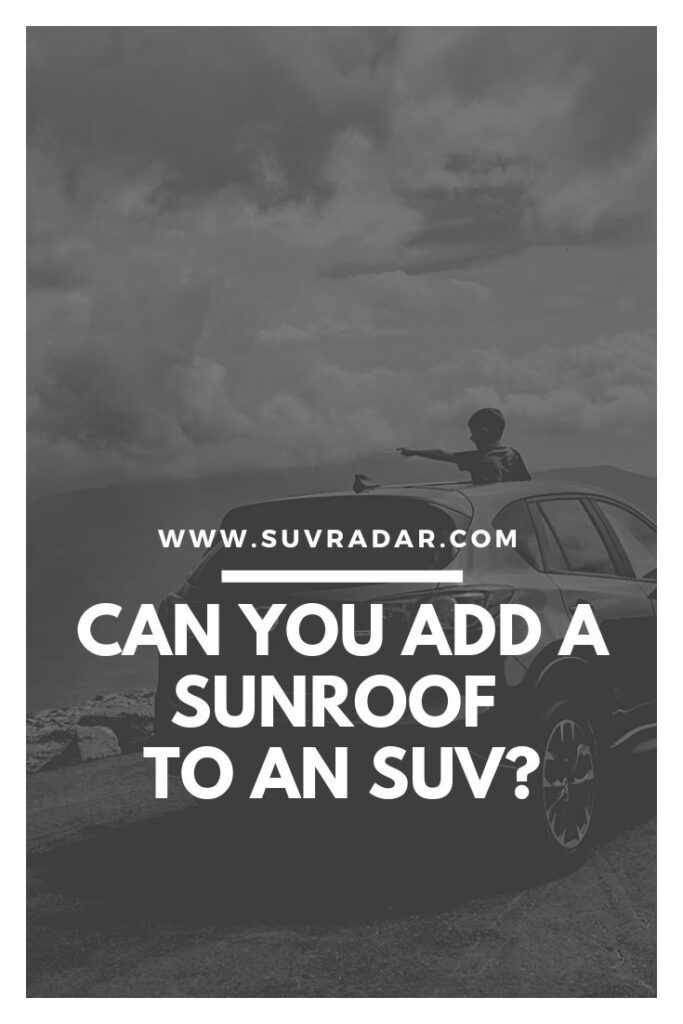There’s no denying that sunroofs can transform your driving experience. The calmness they exude is undeniable coupled with their sleek appearance that adds a touch of elegance to any vehicle. It allows an abundance of natural light to flood the cabin, eliminating any hint of claustrophobia.
Imagine cruising on a rainy day, raindrops dancing on the sunroof glass, as you revel in the symphony of nature while maintaining a dry and cozy interior. It’s the epitome of driving bliss!
If you enjoy the feeling of cruising down the open road, with the wind in your hair and the sun shining through an open roof. Sunroofs might sound like a lovely addition to your car. Adding a sunroof to the top of your SUV is technically possible if your beloved SUV doesn’t come equipped with this desirable accessory.
Let’s explore the advantages and disadvantages of adding Sunroofs to an SUV.

Advantages of Adding Sunroofs to SUVs.
Here are four of the most captivating advantages of sunroofs:
1. Improved Ventilation:
It allows breath of Fresh Air when stuck in traffic, the noxious fumes of exhaust pollutants can feel suffocating. Unlike traditional windows, this ingenious design employs the principles of negative pressure ventilation, allowing a breath of fresh air to permeate your car’s interior.
By harnessing the pressure differential between the air outside and inside the vehicle, a sunroof effortlessly ushers in refreshing breezes while expelling stale air, creating a revitalizing environment for your journey.
2. Enhanced Visibility
The world is a vast canvas waiting to be admired, a sunroof provides an unparalleled window to its wonders. Offering an upward view that invites you to revel in the beauty of your surroundings.
Whether traversing winding roads through scenic landscapes or cruising under starlit skies, the expansive view afforded by a sunroof elevates the driving experience to new heights, connecting drivers and passengers with the world beyond their windshield.
3. A Safe Heaven
In the unfortunate event of an accident, quick and safe excavation becomes paramount. Sunroofs serve as a potential lifesaver.
Should traditional existence be compromised, a sunroof can become a viable alternative, providing an additional means of exit.
Disadvantages of Adding Sunroofs to SUVs.
As much as adding a sunroof to an SUV is technically possible, it’s not a common or recommended practice. There are several reasons why adding an aftermarket sunroof to an SUV can be disadvantageous:
1. Leakages
Aftermarket sunroofs are more prone to leaking compared to factory-installed sunroofs. The installation process may not be as precise, which can lead to potential water breaks during rainfall or car washes. This can cause damage to the interior of the vehicle and result in expensive repairs.
2. Structural Integrity
SUVs are designed with specific structural components that ensure safety in case of accidents, including rollovers. Adding an aftermarket sunroof may compromise the structural integrity of the vehicle, potentially reducing its safety in certain scenarios.
3. Resale Value
While some individuals may enjoy having a sunroof, many potential buyers prefer vehicles with factory-installed sunroofs due to their reliability and the assurance of proper installation. Adding an aftermarket sunroof can negatively impact the resale value of an SUV because it may be seen as an aftermarket modification that potential buyers are not interested in.
4. Voids warranty
It is important to consider the implications on warranties and insurance coverage. Modifying the vehicle’s structure may void the manufacturer’s warranty, potentially leaving you unprotected in the event of future issues.
Considering these factors, it is generally not recommended to add an aftermarket sunroof to an SUV. If you desire a sunroof in your vehicle, it is best to consider purchasing an SUV model that already includes a factory-installed sunroof.
Here are some of the best SUVs with Sunroof.
Ford Escape
The Ford Escape is a crossover that has undergone a remarkable transformation in its latest generation. With a focus on enhancing its car-like appeal, this SUV delivers a thrilling driving experience. Despite a slightly lower ground clearance, the Ford Escape remains a frontrunner in the realm of panoramic sunroofs. Opting for the top-tier Titanium model grants you the opportunity to bask in the luxury of a panoramic sunroof
The Subaru Ascent
The Subaru Ascent is a true game-changer for Subaru enthusiasts. This mammoth SUV takes the crown as Subaru’s largest offering to date, accommodating up to eight passengers and boasting standard all-wheel drive.
Safety is paramount with the inclusion of the coveted EyeSight suite, ensuring peace of mind on every journey. However, it is the Touring trim that truly sets the Subaru Ascent apart, treating passengers to a standard panoramic sunroof that effortlessly elevates the driving experience.
RAV 4
The Toyota RAV4 remains one Sport Utility Vehicle that can leave you captivated. Its striking aesthetics, wealth of amenities, and unwavering reliability have made it an instant favorite among buyers. The RAV4 proudly boasts one of the few panoramic sunroofs available in the compact SUV segment. This optional feature promises to elevate your driving pleasure to new heights.
KIA Sportage.
The KIA Sportage has stood the test of time. While it may show signs of maturity, the Sportage continues to impress with its array of features. Of notable mention is the optional panoramic sunroof, available exclusively in the EX Sport and SX trims equipped with the V6 engine.
Its inclusion creates an illusion of spaciousness within the cabin, defying expectations for a vehicle in this class. Who would have imagined that a Sportage would grace the list of SUVs offering panoramic sunroofs?
Toyota Highlander
The Toyota Highlander sets the benchmark Combining a sleek exterior, refined interior, and the power of a 3.5-liter V6 engine generating 295 horsepower and 263 lb-ft of torque, the Highlander demands attention. The top-tier Highlander Platinum edition further enhances this experience by offering a standard panoramic sunroof that bathes the cabin in natural light. As an added bonus, the 12.3-inch touchscreen display elevates the Highlander Platinum to new heights of modernity.
Closing the curtain
The decision to add a sunroof to your SUV requires careful consideration. While the allure of an open roof and enhanced cabin ambiance is undeniable, it’s important to weigh the potential drawbacks. From leakages and compromised safety to the impact on resale value, there are valid reasons why aftermarket sunroofs are generally discouraged.
If you yearn for the sun-soaked driving experience, it is advisable to explore SUV models that already come equipped with factory-installed sunroofs. Keep in mind; that safety and long-term value should always be top priorities when making modifications to your vehicle.




